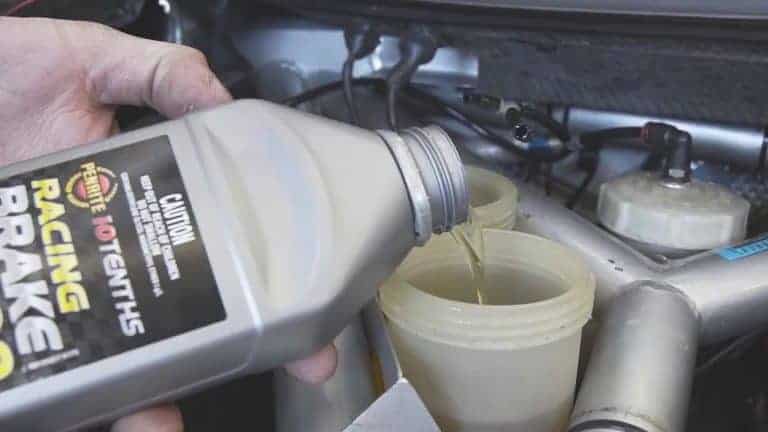Subjects:
- Brake fluid general
- vapor lock
- Properties of brake fluid
Brake fluid general:
With the brake fluid, the force exerted by the foot on the master cylinder is transferred to the wheel brake cylinders. Brake fluid is composed of polyglycol derivatives with various additives. It is a thin liquid with a low pour point that can move quickly through narrow pipes and passages.
The illustration shows the brake fluid circuit of a passenger car. The system is cross-separated;
- Left front with right rear;
- Right front with left rear.
De master cylinder puts pressure on the system. The brake fluid travels through the lines to the brake cylinders of the disc brakes and / or drum brakes.

The braking system of an average passenger car contains approximately 0,25 to 0,5 liters of brake fluid. This small amount must be able to withstand pressures of 15.000 kPa at very high temperatures.
Most of the heat is dissipated via the brake discs/drums to the ambient air. A small part of it ends up in the brake fluid via the brake shoes/brake pads and the wheel brake cylinders. Components of brake fluid attack paint and varnish. If brake fluid comes into contact with the paintwork, it must immediately be thoroughly rinsed with water.

Vapor lock:
Vapor lock occurs when the brake fluid starts to boil; eg when the car is stopped after prolonged braking, or starts to drive slowly without braking. The cooling by driving wind is then minimal. If brake fluid starts to boil, the boiling point is exceeded. It must therefore have a high boiling point to prevent vapor lock formation. No pressure can build up with vapor in the brake system.
Properties of brake fluid:
Brake fluid must meet certain requirements to ensure the reliability of the braking system. Also, brake fluid provides a protective effect for the internal parts; think of the cups in the master cylinder and the inside of brake lines. A number of properties are mentioned in this section.
Boiling point:
The boiling point is indicated by a DOT code. DOT is an abbreviation of “Department Of Transport”.
When brake fluid boils, vapor bubbles form. These vapor bubbles are compressible, so that less pressure is built up. Water also causes corrosion in the braking system. Brake fluid must therefore have a high boiling point. There are 2 types of boiling points used:
- Dry Boiling Point: That is the boiling point of new packaged brake fluid.
- Wet boiling point: This is the boiling point when brake fluid has absorbed about 3,2% water. Brake fluid is hygroscopic (absorbs water). Water lowers the boiling point of the brake fluid. At 1% water, the boiling point is reduced by about 25 degrees.
| Brake fluid requirements | DOT 3 | DOT 4 | DOT 5 | DOT 5.1 |
| Dry boiling point: | 205 ° c | 230 ° c | 260 ° c | 260 ° c |
| Nat boiling point: | 140 ° c | 155 ° c | 180 ° c | 180 ° c |
Brake fluid should be replaced once every two years because moisture and dirt will seep into the brake fluid over time. The boiling point therefore decreases after a number of years.
Hygroscopic:
Hygroscopic means that the brake fluid dissolves or binds water. Water causes corrosion in the braking system and vapor lock.
Viscosity:
Brake fluid must maintain proper viscosity (thickness) at high and low temperatures.
Foaming:
Brake fluid must not be foaming.
Protection:
Brake fluid must provide protection against corrosion in, for example, the brake lines and brake hoses.
Related pages:
